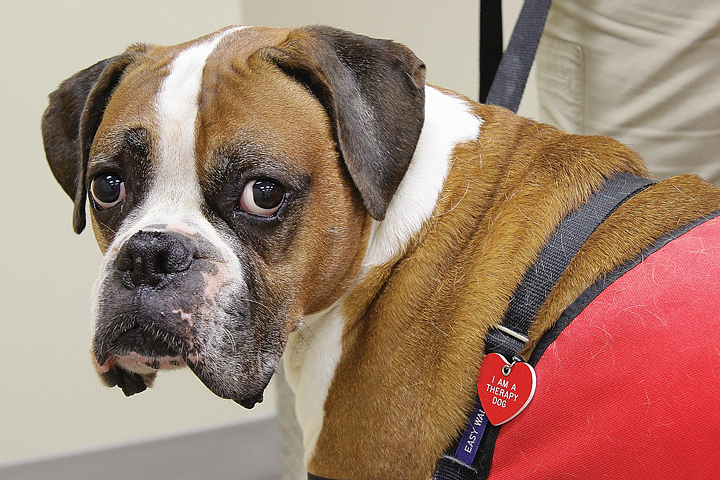It’s another day at New Hanover Regional Medical Center and both Lana Desloges and Samson wear their badges. Lana’s verifies she is a volunteer at the hospital. Samson’s red, heart-shaped badge reads, “I’m a therapy dog.”
Through the doors of NHRMC’s Rehabilitation Hospital, both handler and healer walk. Greeted by Darlene Larkins, a patient at the rehabilitation hospital, the steady boxer Samson approaches to give Larkins a few licks — a simple act that brings tears of joy.
“It does make me feel better because I have two dogs at home I am missing like crazy,” Larkins said. “It is just good to have a dog come in and at least you can be around them.”
Samson’s muscular, square head belies his true nature as a lover and what ensues is a series of licking, petting, dog talk, repeat.
Larkins’ response is similar to many of the patients at the hospital Lana and Samson, and the other 25 therapy dog teams, encounter on their rounds.
Larkins said opening up to a dog is much easier for patients who have been through traumatic events.
“Once you have been hurt or had a stroke you aren’t the same person. Sometimes you shut down to other people because you are either embarrassed of what you are or who you are now,” she said. “The dogs don’t care and they just give you unconditional love.”
Therapy dogs differ from service dogs in that their role is to help foster emotional wellbeing whereas service dogs provide aid with physical handicaps or ailments.
“I don’t think there has been that much said about the therapy dogs, more about service dogs,” Desloges said. “The therapy dog program has become very prevalent lately and they are even getting them into airports where they call them comfort dogs.”
Not just any dog can be a therapy dog, however, and Desloges said she knew she wanted Samson to be her first therapy dog from the time he was a puppy.
“Any dog is a good therapy dog as long as they have the right temperament,” she said. “You will learn really early on what kind of temperament your dog has. They can’t be too shy, they have to be pretty secure in themselves, they have to be social and they have to like touch.”
Samson, who is now 7 and one-half years old, was trained from an early age, going without rope toys or balls to prevent any aggressive mouth movements. In addition to the traditional behavioral and agility dog classes, Samson was also trained by visiting very loud and distracting settings.
“I went to Home Depot and Lowes in the lumber departments because that is where the loudest things were happening,” Desloges said. “From the get-go I knew he was a solid dog emotionally if he could handle that.”
Samson’s training produced a dog Desloges can trust and a dog unfazed by the varying sights, sounds, smells and people he meets in his daily visits to the many wings of the hospital, nursing homes and hospice centers.
In settings like nursing homes, Samson can help with improving motor skills in addition to nurturing emotional health.
“Sometimes they may not feel like moving around too much but they will always pet my dog and feel him, and it helps so much, especially with the elderly because sometimes they are so lonely,” Desloges said. “Also it gives them a sense of touch and love.”
The patients are not the only ones who benefit from Samson’s presence; Desloges said often the staff of the medical establishment benefits just as much.
“At the hospital, we do not only work for the patients, we help de-stress the staff too,” she said. “Often when Samson and I are walking through the halls, we will walk by a doctor who comes right in his face, roughing him up, and Samson just licks his face. It just diverts the staff’s stress energy a little bit.”
NHRMC music therapist and child life specialist Michele Erich said the hospital has had the therapy dog program since the early 1990s and she sees a positive change in everyone with whom the dogs interact.
“There is a switch that turns, a look in their face that is different and a happiness that comes,” Erich said. “No matter whether they are children, the folks in the outpatient cancer center or any other patients, I think it just brightens people’s spirits and it really helps the staff.”
Erich said the therapy dog teams are also starting to have an effect in the waiting rooms of the intensive care and surgical units.
For those looking to train a therapy dog of their own, Desloges suggested starting young and going through training classes at centers like the Azalea Dog Training Club.
Erich said any trained and certified therapy dogs could phone her at 910-815-5870 to begin volunteering at NHRMC.
email [email protected]




